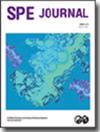野外尺度上未固结地层的改进型连续方法
IF 3.2
3区 工程技术
Q1 ENGINEERING, PETROLEUM
引用次数: 0
摘要
随着油砂和甲烷水合物储层等非常规资源的开发,地下非固结岩力学性能模型的重要性显著增加。未固结岩石常用的数值方法是离散元法(DEM)。然而,由于离散元法需要进行大量计算,因此不足以模拟野外规模的非固结岩行为。另一种方法是连续法,用于模拟野外尺度的非固结岩行为。在以前的连续方法中,未固结岩石被模拟为粘弹性流体(即宾汉流体)。基于粘弹性流体的连续方法使用压力(标量)来描述颗粒的应力状态。然而,在模拟未固结岩石的力学性能时,这种方法没有考虑到原位应力场的最大和最小主应力之间的差异。在此,我们针对未固结岩石开发了一种改进的连续体方法,并使用有限元法作为数值方法。我们改进的模型可以考虑原位应力场最大和最小主应力与未固结岩层孔隙压力之间的差异。我们利用未固结岩石的基准问题--休止角试验验证了我们的数值模型。验证结果证实了我们的非固结模型的准确性。对于未固结模型和流动模型之间的耦合模型,我们使用了分析解法来验证其可靠性。根据我们的耦合模型,研究了注入流体的非固结储层中的非固结岩石性能。模拟结果表明,注入可以激活未固结岩石颗粒的运动,从而改变有效应力和渗透率的分布。我们的模型有望解决大规模未固结岩石问题,为能源开采做出贡献。本文章由计算机程序翻译,如有差异,请以英文原文为准。
An Improved Continuum Approach for Unconsolidated Formations on the Field Scale
With the development of unconventional resources, such as oil sands and methane hydrate reservoirs, the importance of the mechanical performance model for underground unconsolidated rocks has increased significantly. The commonly used numerical approach for unconsolidated rocks is the discrete-element method (DEM). However, the extensive calculations required by the DEM make it inadequate for simulating unconsolidated rock behavior on a field scale. An alternative is the continuum approach, used to simulate the behavior of unconsolidated rocks on the field scale. In previous continuum approaches, unconsolidated rocks have been modeled as a visco-plastic fluid (i.e., Bingham fluid). The continuum approach based on visco-plastic fluid uses pressure (scalar) to describe the stress state of the particles. However, this approach does not account for the difference between the maximum and minimum principal stresses of the in-situ stress field when simulating the mechanical performance of unconsolidated rocks. Here, we developed an improved continuum approach for unconsolidated rocks and used the finite-element method as a numerical approach. Our improved model can consider the difference between the maximum and minimum principal stresses of the in-situ stress field and the pore pressure of the unconsolidated formation. We validated our numerical model with the angle of repose test, a benchmark problem for unconsolidated rocks. The validation results confirm the accuracy of our unconsolidated model. For the coupled model between the unconsolidated model and the flow model, we used an analytical solution to verify its reliability. Unconsolidated rock performances in an unconsolidated reservoir with fluid injection have been investigated based on our coupled model. The simulation results show that injection can activate the movement of unconsolidated rock particles, leading to changes in the distribution of effective stress and permeability. Our model has the potential to address large-scale unconsolidated rock issues and contribute to energy extraction.
求助全文
通过发布文献求助,成功后即可免费获取论文全文。
去求助
来源期刊

SPE Journal
工程技术-工程:石油
CiteScore
7.20
自引率
11.10%
发文量
229
审稿时长
4.5 months
期刊介绍:
Covers theories and emerging concepts spanning all aspects of engineering for oil and gas exploration and production, including reservoir characterization, multiphase flow, drilling dynamics, well architecture, gas well deliverability, numerical simulation, enhanced oil recovery, CO2 sequestration, and benchmarking and performance indicators.
 求助内容:
求助内容: 应助结果提醒方式:
应助结果提醒方式:


